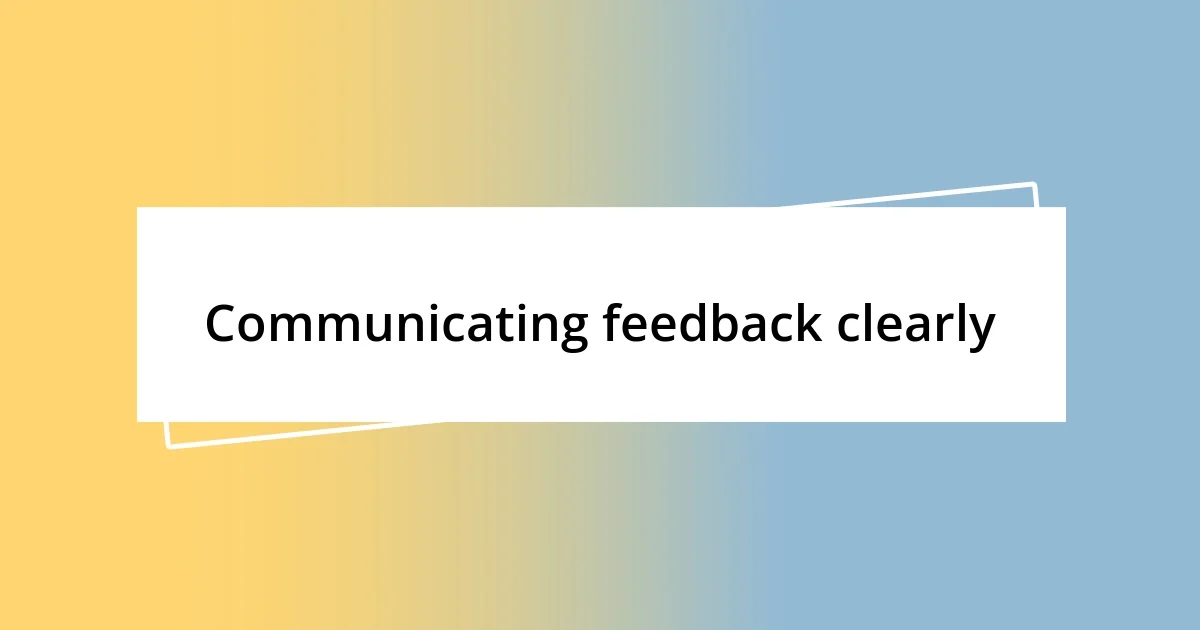Key takeaways:
- Establish a culture of open communication and clear guidelines to foster supportive and effective code reviews.
- Balance positive and constructive feedback to maintain motivation and trust within the team while tailoring critiques to the coder’s experience level.
- Utilize tools like structured templates, analytics, and pair programming to streamline the review process and enhance collaboration.

Key practices for effective reviews
One key practice I’ve found invaluable in code reviews is to build a culture of open communication. I remember a time when it felt daunting to give feedback, fearing it might hurt my colleague’s feelings. Then I realized that the intention behind my reviews was to uplift our work, not tear it down. Do you see how that shift in mindset can change everything?
Another important aspect is to establish clear guidelines for reviews. I once took part in a team where we had a checklist for reviewing code. It not only streamlined our process but also minimized subjectivity in feedback. When everyone knows what to look out for, doesn’t it make the review process feel more supportive and less like a chore?
Lastly, I advocate for the practice of reviewing in pairs or small groups. There was a situation where a complex piece of code needed multiple eyes. Collaborating with someone else to share perspectives made the review richer and more thorough. Have you ever experienced how collaboration can spark creativity? It’s those moments when diverse viewpoints come together that truly enhance the quality of our work.

Structuring your code review process
When structuring your code review process, it’s crucial to define roles and responsibilities clearly. I remember facing confusion in one of my previous projects, where team members had overlapping responsibilities, leading to duplicated efforts and crucial details slipping through the cracks. Once we clarified who was responsible for what during the review, everything felt more organized, and our productivity significantly improved. It was as if a fog lifted, allowing us to focus on what truly mattered: creating great code.
Creating a timeline for your code reviews can also make a substantial difference. I once worked with a team that set specific deadlines for reviews, and it instilled a sense of urgency which helped us stay on track. Having that timeline not only held us accountable but also meant we could quickly pivot if we encountered any issues. Have you ever felt the pressure of a deadline uplift the quality of your work? In this case, it definitely fueled our motivation to be thorough and timely.
Another effective structuring method is tracking feedback. In a project I recall, we utilized a tool to log all feedback given during reviews. This practice turned out to be incredibly helpful, as we could refer back to previous discussions and track progress over time. It was like having a personal diary of our development journey, making it easier to learn from past experiences. Doesn’t it feel rewarding to see how far you’ve come?
| Process Component | Key Benefit |
|---|---|
| Defined Roles | Reduces overlap and confusion |
| Set Deadlines | Enhances accountability and focus |
| Feedback Tracking | Facilitates learning and progress |

Communicating feedback clearly
When it comes to communicating feedback clearly, I’ve learned that specificity is key. Vague comments can leave the recipient feeling confused and unsure about how to improve. Once, I pointed out a general issue in someone’s code, and it led to a lengthy discussion that could have been avoided if I had been more precise. Now, I always try to pinpoint the exact line or function that needs attention, coupled with a brief explanation of why it matters. This not only clarifies my intent but also makes it easier for my colleagues to grasp the bigger picture.
To make communication even clearer, I often rely on structured feedback formats. I’ve found that using bullet points can help break down my thoughts and highlight critical areas:
- Be Direct: Clearly state what the issue is and why it’s important.
- Use Examples: Provide specific instances from the code to illustrate your point.
- Offer Solutions: Suggest potential fixes or improvements to guide the recipient.
- Praise Positives: Acknowledge what they did well to foster a positive atmosphere.
I’ve really seen how this approach dismantles barriers; when team members get feedback that’s easy to digest, the atmosphere shifts from anxiety to collaboration. It’s gratifying to witness how clarity in communication strengthens our connections and empowers us to create better work together.

Balancing positive and constructive feedback
Finding the right balance between positive and constructive feedback can significantly impact the coding environment. I recall being part of a team where feedback was either overwhelmingly positive or harshly critical. After one particularly disheartening review session where only negatives were highlighted, I realized how vital it is to include encouragement alongside critiques. Wouldn’t you agree that hearing something you’ve done well can make you more receptive to improvement suggestions?
Integrating both types of feedback fosters an atmosphere of trust and openness. I remember a colleague once said, “I feel like I can take risks and explore new ideas when criticism is paired with praise.” That stuck with me. When I now provide feedback, I consciously aim to highlight the strengths in the code before delving into areas for improvement. It’s a little like finding the sweetness in a balanced diet; it makes the “healthy” part easier to digest.
Consistency is another key component in balancing feedback. In my experience, regular check-ins where I ensure that everyone gets ample compliments along with constructive remarks contribute to a healthier team dynamic. I often think about how a well-placed compliment can act like a boost of confidence, encouraging someone to tackle the more challenging parts of their work. Haven’t you ever felt ready to conquer your tasks when somebody acknowledged your effort? That’s what makes the combination of positive and constructive feedback truly powerful.

Common pitfalls to avoid
One common pitfall I’ve noticed in code reviews is the tendency to focus solely on syntax errors while neglecting logical flaws. I once reviewed code that was syntactically correct but failed to address a critical edge case. It was disheartening when the issue came to light weeks later, leading to unnecessary complications. This experience taught me to look beyond the surface; while syntax is important, understanding the logic behind the code is just as crucial. Have you ever caught a mistake that stemmed from overlooking a simple logical error? I certainly have, and now I prioritize a holistic review approach.
Another mistake to watch out for is being overly critical without considering the context of the coder’s experience. I remember a time when a colleague was new to a particular framework, and my initial response was too harsh. Instead of fostering their growth, I stifled it. Realizing this, I’ve made it a point to tailor my critiques based on the coder’s skill level. It’s essential to remember—the goal is improvement, not discouragement. How can we expect our team members to learn if they don’t feel supported in their learning journey?
Lastly, I often see reviewers diving into details too quickly and forgetting to appreciate the design as a whole. During one code review, I got so stuck in the weeds of minor changes that I lost sight of the overall structure and flow. It was only after a gentle reminder from a teammate that I took a step back. This taught me the importance of reviewing code holistically first before dissecting individual parts. By encouraging this practice, I’ve seen how it not only improves team dynamics but also helps maintain a broader perspective on what we’re trying to achieve together.

Tools for improving code reviews
When it comes to tools for improving code reviews, I’ve found that utilizing platforms like GitHub and GitLab can streamline the entire process. For instance, I remember the first time I used pull request templates; having a structured format for feedback not only saved time but also ensured that no critical points were overlooked. It’s fascinating how a simple template can guide reviewers to focus on essential aspects while also fostering a consistent approach across the team. Have you used such templates? If not, I highly recommend giving them a try.
Another tool that’s made a significant impact for me is code review analytics. Analyzing data like review time and the number of comments helps identify bottlenecks and highlights areas needing improvement. I once analyzed a project that had unusually long review times and discovered that certain team members were hesitant to share their thoughts. By acknowledging this and encouraging open communication, we dramatically reduced the time spent on reviews. Isn’t it interesting how data can not only reveal patterns but also direct our actions for better collaboration?
Lastly, incorporating pair programming as a tool has transformed the way I think about code reviews. I vividly recall a pair session where we tackled a particularly challenging piece of code together. Instead of waiting for a formal review, we collaborated in real-time, catching issues as they arose. It created a sense of camaraderie and trust, making feedback feel less like a chore and more like a shared journey. Have you ever experienced the power of collaboration in your reviews? I believe there’s always something new to learn from a colleague’s perspective.













